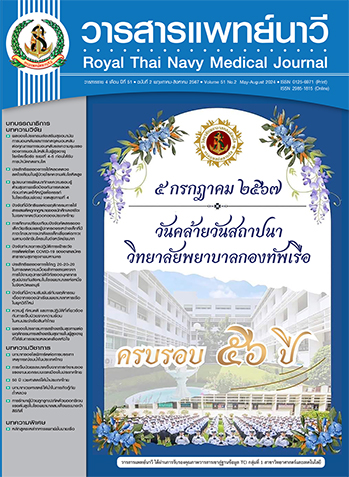A Model of Health Literacy Skills Development for Preventing Preterm Birth of Pregnant Women in the Parental Schools under Health Region 4
Main Article Content
Abstract
Preterm birth in pregnant women is a crucial problem in maternal and child health work. It has direct effects towards physical conditions of baby and mother. Psychologically, it also causes stress and anxiety, including economic impact on the costs of consecutive care over a long period of time. This research and development aimed to develop and evaluate health literacy skills for preventing preterm birth in pregnant women for the Parental Schools under Health District No. 4. This research and development consisted of 2 phases: 1) Construct health literacy skills development model for preventing preterm birth for pregnant women; and 2) Operationalize and evaluate the health literacy skills development model for pregnant women. The samples were 60 pregnant women under prenatal care service at 7 hospitals. The data collection employed document analysis and questionnaire. The qualitative data was analyzed by content analysis, while the quantitative data was analyzed using descriptive statistics and the paired t-test.
The study found that 1. The constructed model consisted of 11 processes including: 1) Communicate/invite and select pregnant women to participate in developing health literacy skills; 2) Persuade or motivate the target group to set goals for achieving full-term delivery; 3) Train information management skills in searching, filtering, and verifying the data; 4) Search the data for the topic “Problems of Preterm Birth”; 5) Search the data for the topic “How to Prevent Preterm Birth;” 6) Train inquiry skills; 7) Train decision-making skills; 8) Train decision-making with new problems; 9) Train application skills; 10) Review the trained skills. 11) Share good practices in preventing preterm birth without limitation of stories or examples. 2. After operationalizing the model, it was found that pregnant women showed higher literacy level than that of the pre-operationalizing of the model (p < .01) regarding preterm birth literacy, health literacy in preventing preterm birth, and preventive behaviors for preterm birth.
Article Details

This work is licensed under a Creative Commons Attribution-NonCommercial-NoDerivatives 4.0 International License.
References
Hesketh KR, Evenson KR. Prevalence of US pregnant women meeting 2015 ACOG physical activity guidelines. Am J Prev Med 2016;51(3):1-3.
Women ACoHCfU. ACOG Committee Opinion No.524: Opioid abuse, dependence, and addiction in pregnancy. Obstetrics and gynecology 2012;119(5):1070-6.
Leelahapongsathorn W, Chantathip P J. Evidence based practice guidline in labour room at Kingnarai Hospital. Journal of Nursing Division 2016;43(special):46-62. (in Thai).
Flicek P, Amode MR, Barrell D, Beal K, Billis K, Brent S, et al. Nucleic acids research. Ensembl 2014;42(1):749-55.
Kongrod S, Chaiyarit C. Effectiveness of an education program on knowledge, attitude and practice of pregnant women with premature labour. Journal of Health Science 2020;29(6):1055-61. (in Thai).
Moglia PP. Premature birth. Hackensack: Salem Press; 2019.
Nutbeam D. Health Literacy as a public health goal: a challenge for contemporary health education and communication strategies into the 21st century. Health Promotion International 2000;15(3):259-67.
Duggan L, McCarthy S, Curtis LM, Woif MS, Noone C, Iggins JR, et al. Associated between health literacy and beliracy and beliefs about medicines in an lrish obstetric population. J Health Commun 2014;19(2):106-14.
Sitkulanan P. Nursing care for pregnant women at risk of preterm labour. Nursing Science Journal of Thailand 2007;25(2):4-12. (in Thai).
Thawaro J. Comparison of clinical outcomes of late term preterm infant with full term infant in Nongbualamphu hospital. Sanpasitthiprasong Medical Journal 2021;42(2):53-61. (in Thai).
Pattanapongthorn J. School manual’ s parents for children "Good health, good brain, good mood, happiness". 3nd ed. Department of Health, Ministry of Public Health: New Thammada Press; 2016. (in Thai).
Dale Edgar. Audio-Visual Methods in Teaching. 3rd ed. New York: Holt, Rinehart & Winston; 1969.
Kaeodumkoeng K, Chaiyaparn N, Boonkla S. A program development of promoting health literacy on disease prevention and control in Public Health Officers. Thai Journal of Health Education 2021;40(2);187-201. (in Thai).
Polit D F, Beck C T. Nursing research: generating and assessing evidence for nursing practice Eighth Edition. Philadelphia, Pa: Lippincott Williams & Wilkins; 2008.
Lahukarn B, Kala S, Krischaroen S. The Effects of an education and progressive muscle relaxation program on stress among pregnant women with preterm labor pain. The Southern College Network Journal of Nursing and Public Health 2019;6(2):1-13. (in Thai).
Bloom S. Learning for mastery. Evaluation comment. Center for the study of instruction program. University of California at Los Angeles; 1986.
Khokkaew A, Chulert P, Kulpanich M. The effects of a health promotion program on knowledge and self-care behavior for pregnant teenagers. Journal of MCU Nakhondhat 2022;9(8):17-31. (in Thai).
Choeisuwan V. Health Literacy: Concept and application for nursing practice. RTN Med J 2017;44(3):183-197. (in Thai).


